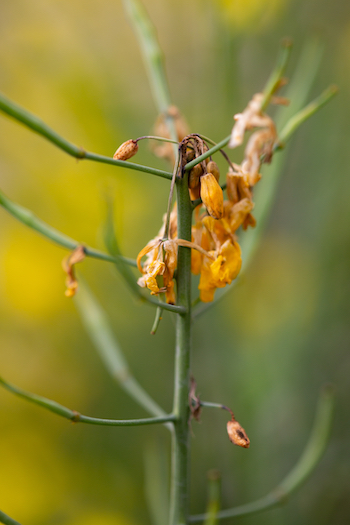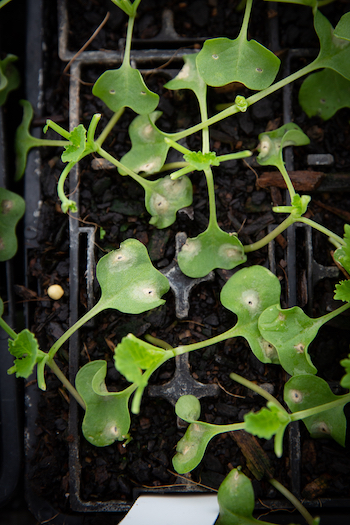 Blackleg infection on a canola flower. Photo: Marcroft Grains Pathology
Blackleg infection on a canola flower. Photo: Marcroft Grains Pathology
Blackleg disease, caused by the fungal pathogen Leptosphaeria maculans, is a stubble-borne disease that leads to seedling, crown canker and upper canopy infection. Blackleg disease is minimised through a three-pronged approach of genetic resistance, cultural practices (including stubble management) and fungicides.
With investment from GRDC, a collaboration between the University of Melbourne, Marcroft Grains Pathology and CSIRO is working to improve management strategies to reduce the impact of this disease through molecular and field-based approaches.
Central to this analysis was the establishment of 32 monitoring sites across canola-growing regions in association with the National Variety Trials program. The project uses canola cultivars that represent different resistance groups (which harbour different complements of major resistance genes) and monitors them for changes in disease severity.
The project is near completion, with the data from the past five seasons pointing to some key findings.
Changes in stubble management
As long as stubble stays intact, it will release blackleg spores within the growing season. In fact, spore release has been measured from canola stubble that is four years old. This means stubble quantity (rather than stubble management) has the largest effect on blackleg disease. However, blackleg will release fewer spores as the stubble and the fruiting bodies age.
An increase in area cultivated with canola will result in increased canola stubble and, therefore, increased blackleg spore density. Spore density typically (but not always) results in increased disease severity. The increase in the area of canola stubble also reduces the ability of growers to maintain a 500-metre buffer between one-year-old stubble and current crops.
Seasonal conditions will then influence whether crown canker or upper canopy infection (UCI) will be more significant and potentially warrant control. It will be rare to have severe forms of both versions of blackleg in the same year.
- Crown canker years occur from late sowings, which results in plants remaining as seedlings during the winter infection period.
- UCI years will likely arise from early sowings, which results in plants starting flowering in late July to early August. Early flowering will result in increased infection and will give the fungus more time to cause damage prior to harvest.
Overall, the canola industry is likely to become more reliant on fungicides due to increasing canola production. However, the decision to use a fungicide is not clear-cut. Growers must first understand their crop’s disease risk profile.
Prior to sowing, the BlacklegCM decision support app can be used to identify high-risk paddocks and explore management strategies to reduce yield loss.
Fungicide application for UCI is a separate decision-making process from crown canker control. UCI fungicide application can result in very variable yield returns. Growers must understand the risk before applying a fungicide.
Strategies to control upper canopy infection
 Blackleg lesions on canola leaves. Photo: Marcroft Grains Pathology
Blackleg lesions on canola leaves. Photo: Marcroft Grains Pathology
UCI refers to the development of blackleg lesions on the upper stem, branches, flowers and peduncles.
Trials have shown that the 30 per cent bloom fungicide spray timing is effective at minimising the severity of UCI.
While fungicides reliably reduce disease levels, the likelihood of the fungicide giving a yield return varies dramatically. Data suggest that thermal time, water stress and genetic resistance could all be contributing to the ability of a fungicide application to generate a yield response.
Further investigations are underway to determine the factors contributing to yield responses, which will then be incorporated into the BlacklegCM app.
Additionally, glasshouse experiments at Horsham and Canberra under controlled environments (using individual fungi isolates) found additional effects worth noting.
These findings relate to cultivars with no effective major gene resistance (MGR). Field observations had previously led to assumptions that these cultivars are all equally susceptible to UCI. However, data now suggests that there is underlying genetic ‘quantitative resistance’ to UCI, which acts in a similar manner to the control of crown canker.
Further investigation in 2022 in the glasshouse and field confirmed that the presence of quantitative resistance is effective against UCI, with all commercial cultivars now undergoing screening. The aim is to produce UCI blackleg ratings for all commercial cultivars.
That means cultivars lacking effective MGR might still have useful quantitative resistance and are not as susceptible to UCI as initially thought. This could contribute to variability in yield returns when fungicides have been applied to minimise disease.
Monitoring major gene resistance
While MGR effectively minimises blackleg disease, the blackleg can rapidly evolve to overcome resistance, especially when MGR-harbouring cultivars are sown in multiple consecutive years.
Monitoring at 32 trial sites is providing data relating to which resistance genes are effective in various canola-growing regions. This regional data is released annually and can be found here.
An example of how this monitoring works occurred in 2020 when data indicated that Group H resistance was being overcome in the Hamilton region in western Victoria. Molecular analysis of the isolated fungi revealed that they harbour virulent mutations. Discussions with the affected grower found that the Group H cultivars had been sown for a number of years there as a grain-and-graze option.
In 2021 and 2022, the following was found.
- Resistance groups A, B and C were ineffective in all regions;
- Blackleg resistance group BF was effective at three sites and in the process of being overcome at an additional 13 sites; and
- Blackleg resistance groups AD, ABDF and H were effective at almost all sites.
While our monitoring data can be used to complement grower decisions, we recommend that growers monitor disease levels in their own paddocks to determine whether the MGR in their cultivars is effective. See the Blackleg Management Guide for additional details on best approaches for monitoring a paddock.
More information: Steve Marcroft, steve@grainspathology.com.au
All current management strategies and advice regarding blackleg can be found in the Blackleg Management Guide, which is updated biannually, as well as the BlacklegCM app, available for Android and Apple users.

























































